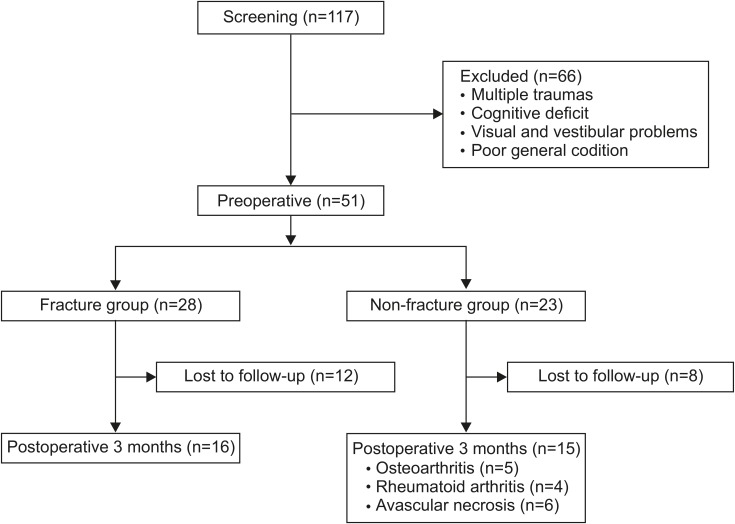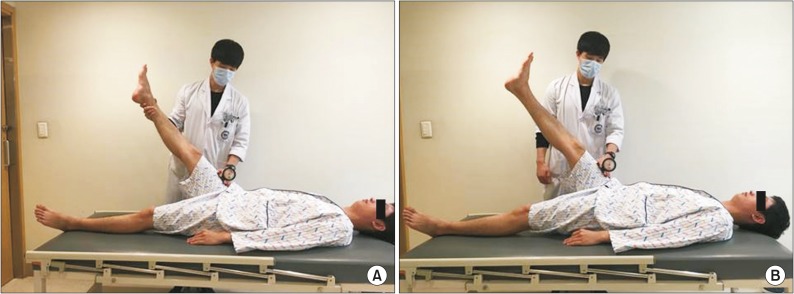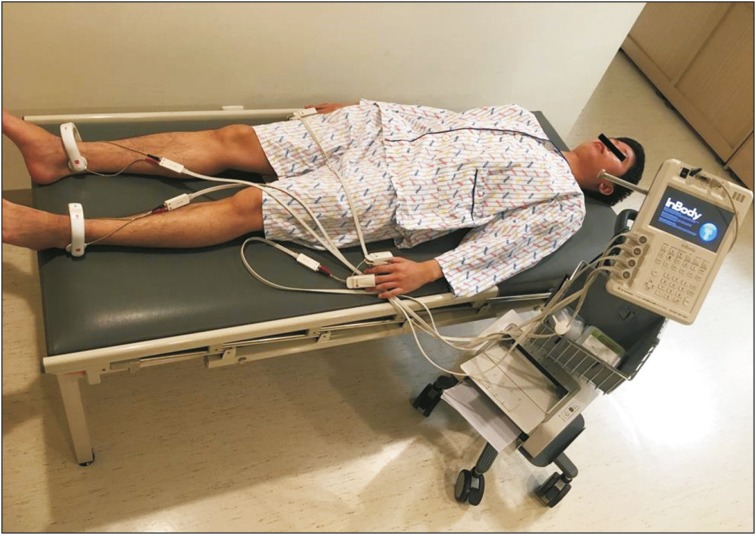Ann Rehabil Med.
2016 Dec;40(6):1064-1070. 10.5535/arm.2016.40.6.1064.
Comparison of Balance, Proprioception and Skeletal Muscle Mass in Total Hip Replacement Patients With and Without Fracture: A Pilot Study
- Affiliations
-
- 1Department of Rehabilitation Medicine, Hanyang University Medical Center, Hanyang University College of Medicine, Seoul, Korea. dumitru1@hanyang.ac.kr
- 2Department of Orthopedic Surgery, Hanyang University Medical Center, Hanyang University College of Medicine, Seoul, Korea.
- KMID: 2371339
- DOI: http://doi.org/10.5535/arm.2016.40.6.1064
Abstract
OBJECTIVE
To determine whether there was a difference in balance, proprioception, and skeletal muscle mass among patients who undergo hip fracture surgery relative to and elective total hip replacement (THR).
METHODS
Thirty-one THR patients were enrolled. The patients were categorized into two groups: fracture group (n=15) and non-fracture group (n=16). Berg Balance Scale (BBS) was used to balance the proprioception of the hip joint while a joint position sense (JPS) test was used to evaluate it. Skeletal muscle mass was measured by bioelectrical impedance analysis and expressed as a skeletal muscle mass index (SMI). Quality of life (QOL) was also assessed using a 36-item short form health survey (SF-36). All tests were assessed at 3 months after the surgery. An independent t-test was used to compare the fracture group and non-fracture group. Spearman correlation was used to identify the correlation of each variable.
RESULTS
In an independent t-test, the BBS score of patients undergoing elective surgery was higher than the BBS score of patients undergoing hip fracture surgery. There was a significant correlation between the BBS and JPS score after a THR. SMI also correlated with the score of BBS.
CONCLUSION
It seems that THR patients undergoing surgery for a hip fracture might have more trouble balancing than elective THR patients. Therefore THR patients undergoing hip fracture surgery might need more care during rehabilitation.
Keyword
MeSH Terms
Figure
Cited by 1 articles
-
Correlation Between Mechanography and Clinical Parameters at Six Months After Hip Fracture Surgery
Tae Jun Min, Junmo Cho, Yong-Chan Ha, Jae-Young Lim, Si Hyun Kang, Don-Kyu Kim, Kyung Mook Seo, Jaewon Beom
Ann Rehabil Med. 2019;43(6):642-649. doi: 10.5535/arm.2019.43.6.642.
Reference
-
1. Wykman A, Goldie I. Postural stability after total hip replacement. Int Orthop. 1989; 13:235–238. PMID: 2599698.
Article2. Lephart SM, Pincivero DM, Rozzi SL. Proprioception of the ankle and knee. Sports Med. 1998; 25:149–155. PMID: 9554026.
Article3. Skinner HB, Wyatt MP, Hodgdon JA, Conard DW, Barrack RL. Effect of fatigue on joint position sense of the knee. J Orthop Res. 1986; 4:112–118. PMID: 3950803.
Article4. Swash M, Fox KP. The effect of age on human skeletal muscle: studies of the morphology and innervation of muscle spindles. J Neurol Sci. 1972; 16:417–432. PMID: 4261815.
Article5. Kim GH, Suzuki S, Kanda K. Age-related physiological and morphological changes of muscle spindles in rats. J Physiol. 2007; 582:525–538. PMID: 17495047.
Article6. Bruce MF. The relation of tactile thresholds to histology in the fingers of elderly people. J Neurol Neurosurg Psychiatry. 1980; 43:730–734. PMID: 7431035.
Article7. Wingert JR, Welder C, Foo P. Age-related hip proprioception declines: effects on postural sway and dynamic balance. Arch Phys Med Rehabil. 2014; 95:253–261. PMID: 23994251.
Article8. Thewlis D, Hillier S, Hobbs SJ, Richards J. Preoperative asymmetry in load distribution during quiet stance persists following total knee arthroplasty. Knee Surg Sports Traumatol Arthrosc. 2014; 22:609–614. PMID: 23881256.9. Majewski M, Bischoff-Ferrari HA, Gruneberg C, Dick W, Allum JH. Improvements in balance after total hip replacement. J Bone Joint Surg Br. 2005; 87:1337–1343. PMID: 16189304.
Article10. Lugade V, Klausmeier V, Jewett B, Collis D, Chou LS. Short-term recovery of balance control after total hip arthroplasty. Clin Orthop Relat Res. 2008; 466:3051–3058. PMID: 18781366.
Article11. Rasch A, Dalen N, Berg HE. Muscle strength, gait, and balance in 20 patients with hip osteoarthritis followed for 2 years after THA. Acta Orthop. 2010; 81:183–188. PMID: 20367414.
Article12. Judd DL, Dennis DA, Thomas AC, Wolfe P, Dayton MR, Stevens-Lapsley JE. Muscle strength and functional recovery during the first year after THA. Clin Orthop Relat Res. 2014; 472:654–664. PMID: 23817756.
Article13. Shumway-Cook A, Horak FB. Assessing the influence of sensory interaction of balance: suggestion from the field. Phys Ther. 1986; 66:1548–1550. PMID: 3763708.14. Arnold W, Schliebe G. Gait analysis in patients with total hip endoprosthesis. Part II: Pre- and postoperative gait analysis. Z Gesamte Inn Med. 1992; 47:15–20. PMID: 1570718.15. Bogle Thorbahn LD, Newton RA. Use of the Berg Balance Test to predict falls in elderly persons. Phys Ther. 1996; 76:576–583. PMID: 8650273.
Article16. Riemann BL, Myers JB, Lephart SM. Sensorimotor system measurement techniques. J Athl Train. 2002; 37:85–98. PMID: 16558672.17. Janssen I, Heymsfield SB, Ross R. Low relative skeletal muscle mass (sarcopenia) in older persons is associated with functional impairment and physical disability. J Am Geriatr Soc. 2002; 50:889–896. PMID: 12028177.
Article18. Jenkinson C, Coulter A, Wright L. Short form 36 (SF36) health survey questionnaire: normative data for adults of working age. BMJ. 1993; 306:1437–1440. PMID: 8518639.
Article19. Goldie PA, Bach TM, Evans OM. Force platform measures for evaluating postural control: reliability and validity. Arch Phys Med Rehabil. 1989; 70:510–517. PMID: 2742465.20. Lephart SM, Perrin DH, Fu FH, Gieck JH, McCue FC, Irrgang JJ. Relationship between selected physical characteristics and functional capacity in the anterior cruciate ligament-insufficient athlete. J Orthop Sports Phys Ther. 1992; 16:174–181. PMID: 18796757.
Article21. Le Manach Y, Collins G, Bhandari M, Bessissow A, Boddaert J, Khiami F, et al. Outcomes after hip fracture surgery compared with elective total hip replacement. JAMA. 2015; 314:1159–1166. PMID: 26372585.
Article22. Lindemann U, Becker C, Unnewehr I, Muche R, Aminin K, Dejnabadi H, et al. Gait analysis and WOMAC are complementary in assessing functional outcome in total hip replacement. Clin Rehabil. 2006; 20:413–420. PMID: 16774092.
Article23. Swanik CB, Lephart SM, Rubash HE. Proprioception, kinesthesia, and balance after total knee arthroplasty with cruciate-retaining and posterior stabilized prostheses. J Bone Joint Surg Am. 2004; 86-A:328–334. PMID: 14960678.
Article24. Beloosesky Y, Hendel D, Weiss A, Hershkovitz A, Grinblat J, Pirotsky A, et al. Cytokines and C-reactive protein production in hip-fracture-operated elderly patients. J Gerontol A Biol Sci Med Sci. 2007; 62:420–426. PMID: 17452737.
Article25. Miller RR, Shardell MD, Hicks GE, Cappola AR, Hawkes WG, Yu-Yahiro JA, et al. Association between interleukin-6 and lower extremity function after hip fracture: the role of muscle mass and strength. J Am Geriatr Soc. 2008; 56:1050–1056. PMID: 18410321.
- Full Text Links
- Actions
-
Cited
- CITED
-
- Close
- Share
- Similar articles
-
- Relationships among Lower Extremity Muscle Circumference, Proprioception, ROM, Muscle Strength, and Balance Control Ability in Young Adults
- The Changes of Postural Balance in Patients with Total Hip Arthroplasty
- Sarcopenia in women with hip fracture: A comparison of hormonal biomarkers and their relationship to skeletal muscle mass and function
- Functional Review of the Hemiarthroplasty Vs, Total Joint Replacement in the Femur Neck Fracture
- Posterior Approach to Total Hip Joint Replacement Arthroplasty




